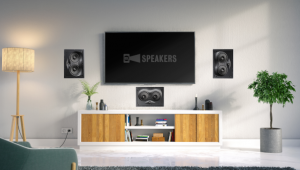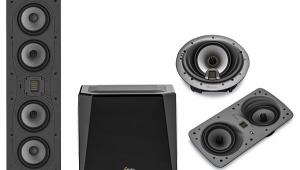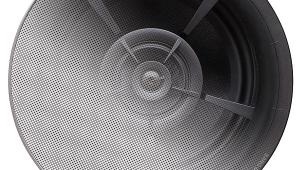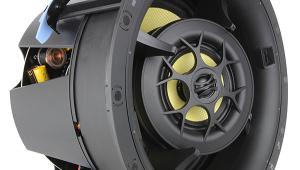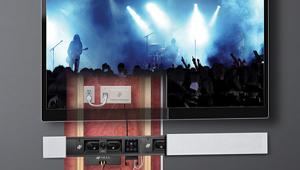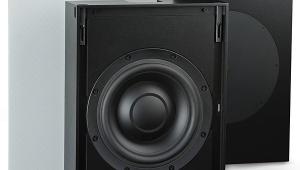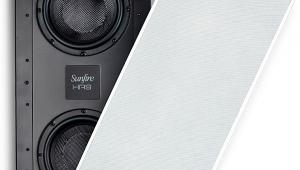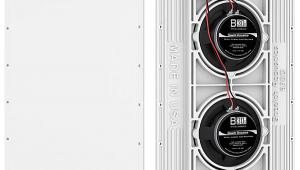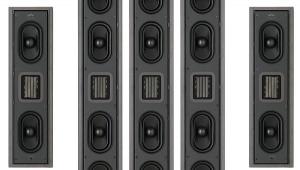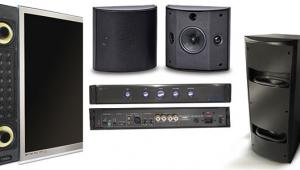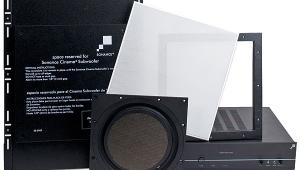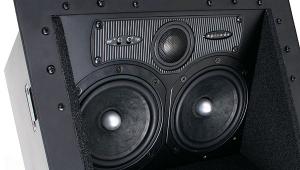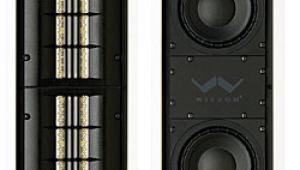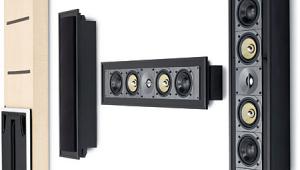Morel SoundWall LCR4 SW In-Wall Modular Soundbar System Review
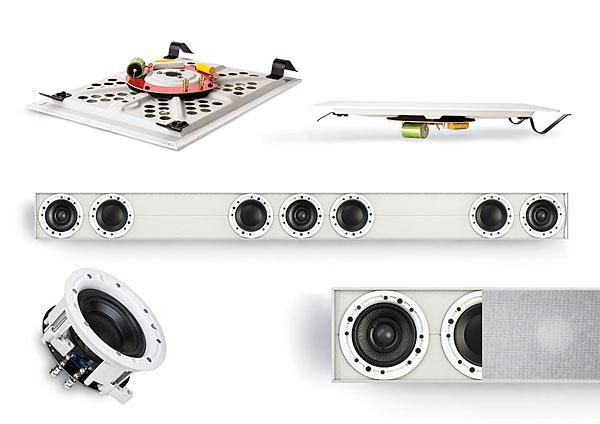
AT A GLANCE
Plus
Requires no modifications to internal wall structure
Adjustable-width grille
Minus
Passive system
Needs a subwoofer
THE VERDICT
If you like simplicity and hate seeing speakers, but demand high performance for music and movies, these SoundWalls may
be what you’ve been waiting for.
I could start this review by making a comparison between Morel, the loudspeaker company, and morel, the type of mushroom. But someone would no doubt castigate me (or worse) for not referring to morchella, the more technically correct name for morel mushrooms—and therefore, that same someone would deem my comparison to be a mighty poor excuse for an introduction to a Test Report. So, I’ll simply say that Morel is an unusual speaker company, in many ways.
Mind you…I don’t think I’ve ever eaten a morel mushroom, but I’ve been told by restaurant-owning friends who are in the know about such things that these wild mush- rooms are a difficult-to-hunt, infrequently discovered, gourmet delicacy when it comes to fungi. And as far as I can tell, the speaker brand Morel, founded in 1975 by Meir Mordechai, has nothing to do with mushrooms. (According to the company, the Morel name came from Mordechai Electro-acoustics.)
That said, Morel and the morels have a couple of things in common—one of which is being uncommon. You won’t find Morel speakers in big-box stores, mall pop-up kiosks, or flea markets. Morel is one of the few remaining loudspeaker companies that is privately owned (rather than being part of an investment group’s portfolio) and that makes its own components—just about everything except for the cabinets. In fact, Morel sells many of the raw drivers it manufactures around the world to both OEM speaker companies and DIY speaker-building consumers. Perhaps the most unusual thing about Morel is that they have their hands in nearly every consumer loudspeaker category: car audio, home theater, stereo pairs, raw drivers, and models designed for custom installation applications.
Variations on a Theme
Yet another of Morel’s unusual aspects is that the company is quite willing to truly think outside the box when it comes to the design
of speakers, as well as to how
and where they’ll be used. The company’s SoundSpot satellite speakers use small, spherical, steel-walled enclosures (“small balls you can be proud of,” as a cheeky reviewer once wrote), and they include a unique mounting system that rotates horizontally and vertically, making it easy to implement on-wall, on-ceiling, or on-shelf placement without additional hardware. Ten years ago,
I reviewed Morel’s Vario on-wall speaker system. It incorporated a cleverly designed, multiple-panel grille that could be extended or retracted—like a set of sliding glass doors—to match the width or height of the accompanying TV or décor. The latest “one speaker, many con-
figurations” creation from Morel is the SoundWall LCR in-wall modular soundbar system.
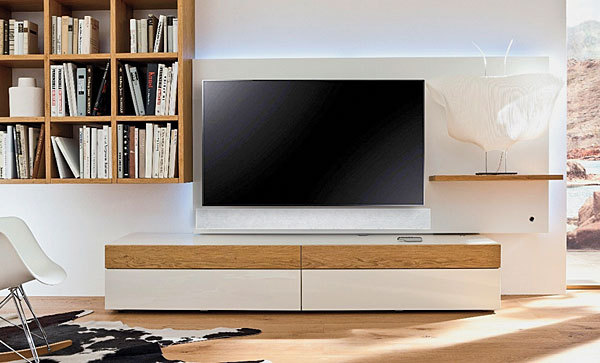
Morel’s design goals for this new system included “high fidelity audio” (duh), affordability (nice!), easy installation (tell me more), and a modular approach that could adapt to various screen sizes and wall types (OK, now that’s just crazy talk). To point out the obvious, which might not be so obvious to some: Although the SoundWall LCR is a soundbar (albeit an in-wall version), it’s a passive model. In other words, you’re going to need an A/V receiver to get sound out of it. The other important thing to note is that the SoundWall LCR isn’t designed to create a simulated surround experience. For a complete 5.1-channel system, you’ll have to add a subwoofer and a pair of rear speak- ers. For this review, Morel shipped the full-blown SoundWall LCR4 SW setup plus a pair of the company’s new SoundWall Surface SH17C semi-hidden in-wall speakers to use for surrounds. (More on that later.)
The basics of the SoundWall LCR are surprisingly simple and straightforward. Its three individual elements can be used in different combinations to create several different soundbar configurations, from a two-channel version all the way to the hard-hitting LCR arrangement I installed in my wall.
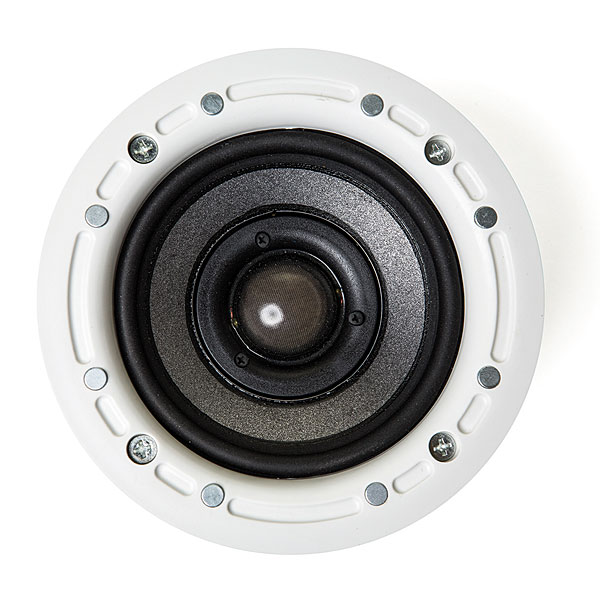
The first piece of kit is the IC-4M I Integra Point Source Module. It’s a shallow (3.34-inch) two-way driver with a mechanical structure that concentrically aligns a 1.1-inch soft-dome tweeter with a 4-inch woofer in a common chassis, in order to get a “near perfect time-aligned” configuration. The IC-4M I includes an impressively large 2.1-inch high-temperature Hexatech aluminum voice coil that’s wound using 100-percent aluminum “honeycomb-shaped” wire. Morel says this design reduces air gaps in the coil windings, which increases the efficiency by up to 20 percent. The woofer’s hybrid motor drive system marries a ferrite magnet with a neodymium magnet (I didn’t know that was legal) to make it up to four times more attractive (and repulsive), magnetically speaking, than similarly sized conventional designs.
More Four?
No matter how powerful the magnet or how tasty the wire, a 4-inch bass driver is still a 4-inch driver. The physics of sound, after all, is a
bitch. So the next element in the SoundWall LCR’s bag of components is the IC-4M W Bass/Sub Module. It’s another 4-inch cone driver with a shallow construction that unifies the dust cap and the diaphragm into a single piece. There’s a shi—boatload of other design characteristics that enable this modest-sized driver to produce bodacious sound, including an under-hung voice coil (I’ll resist the “small balls” reference that I could make here…) with a winding height that’s shorter than the length of the magnetic gap. Morel says this keeps the voice coil continuously within the magnetic energy field, “leading to greater articulation and transient response.” There’s also the Hexa-
tech aluminum voice coil, and…OK, you get the point. These 4-inchers aren’t generic, off-the-shelf drivers. Interestingly, they inherited a lot of their special design attributes from Morel’s experience with car audio, where a speaker’s performance versus size is always a crucial concern. The same is typically a factor in custom home loudspeaker design as well.

The final element in the SoundWall LCR soundbar is the white, four-piece grille assembly, consisting of a mounting track that measures 63 inches wide by 5.5 high, an aluminum grille that slides into ridges along the top and bottom of the track (once the speakers have been installed), and a pair of end caps. The modular nature of the grille assembly makes it easy to cut the width of the track and grille to size and then reseat the cap on the freshly trimmed end—making it look like it was manufactured at that length.
Seven Holes in One
The biggest, baddest, best-est configuration of Morel’s in-wall modular soundbar is the SoundWall LCR4 SW, which is designed for the front LCR channels. My review setup consisted of an IC-4M I Integra Point Source Module paired with an IC-
4M W Bass/Sub Module for the left channel plus another combo for the right channel. The center channel included an IC-4M I flanked by a pair of IC-4M Ws. The first step in the installation was to cut the mounting track and the grille
to size and then attach the track to the wall using the two strips of sticky tape on the back of it. In my situation, the original 63-inch width was darn near perfect, so no grilles were harmed in the making of this review.
Since the LCR4 SW is an in-wall system, I couldn’t avoid drywall surgery entirely, of course. I still needed to create some holes in my wall—seven, actually, with each measuring 125mm (4.92 inches) in diameter. Usually, I’d begin a long bitching-and-moaning session at this point, because I hate the dust and the inevitable bodily harm that comes from jamming a drywall knife into a wall. Morel kindly includes a 125mm hole saw with each SoundWall LCR system to make things easy.
The installer-friendliness doesn’t stop there. You might think that not having precut openings for the speaker modules in the mounting track would make things difficult. It’s actually the reverse because it allows you to choose the location of each driver, based on where the studs in the wall are. This means you don’t have to brutally modify a stud; rather, it’s infinitely easier to mount a module an inch or two to the left or right and avoid them. Of course, this might have a slight impact on the quality of the sound overall, but the tradeoff for ease of installation is totally worth it in many circumstances.
The speaker wires from your AVR attach to the three IC-4M I modules. Each of those modules has passive crossovers with output terminals for connecting to its companion IC-4M W bass module—or, in the case of the center channel, its two com- panions, which are connected in parallel. If there’s a stud between an IC-4M I and its IC-4M W, the one modification that might have to be made is drilling a hole in the stud for the speaker wire to pass through. Last, you slide the perforated aluminum grille into place, followed by the end caps.

